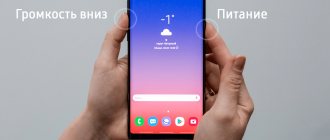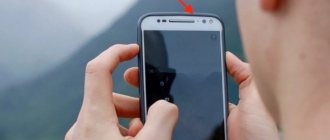Do you know well how your smartphone works, at least externally? I think yes. Display, cameras, power and volume buttons, charging connector and some technical sensors on the front panel. That, in fact, is the entire structure of most modern smartphones. Another thing is that a smartphone is, in principle, a rather complex thing, and often things can happen to it that you would not expect from it. For example, when the display starts to turn off by itself and does not respond to touches if, say, its camera is blocked. What it is? Let's try to figure it out.
Does your smartphone screen turn off if you block the camera? This is the norm
Why only iPhone and OnePlus have such a cool mute switch
Recently we already had a lot of material dedicated to all the black sensors that are placed on the bodies of our smartphones. You can read it if interested. It describes in detail what these sensors are, how they work and why they are needed at all.
Locking the screen with an iPhone case
Victor On iOS 9, as soon as I opened Smart Cover, the iPad immediately opened the desktop.
This doesn't work on iOS 10. Victor Please tell me if you have encountered this. If I install iOS 10 on my iPad and open the Smart Case, will I need to press the Home button to unlock my iPad? Now on iOS 9.3.5 I just open the cover of the case and it automatically goes to my Desktop.
Will it be the same on iOS 10 or will you still need to press the Home button to unlock when opening the lid?
With the release of iOS 10, Apple really changed the device unlocking algorithm. But the Smart Case is the company’s signature accessory and, despite the popular belief that “it doesn’t work after updating to iOS 10,” this is a misconception.
In the iOS 10 settings there are two items responsible for the behavior of the lock screen and the Home key:
- Settings -> General -> Display and brightness
- Settings -> General -> Accessibility -> Home
To ensure that when you open the Smart Case, the iPad automatically turns on and does not require you to enter a password and press the Home key, do the following:
1. Go to Settings -> Touch ID & Passcode and remove the lock password. It shouldn't be there (including the Touch ID fingerprint scanner).
2. Open Settings -> Display and Brightness and turn on the slider next to Lock/Unlock.
Please note that not having a password is not safe for your data. Apple recommends setting a lock password
Source
Installing the application
You will be prompted to select a browser and remember your choice.
Since we have a model for Mi Max, we choose Round, presented in the form of a round dial. For other models (Redmi Note 4X, Mi Note 2, Redmi 4 Pro) you can choose the Square Window style with a clock and date in 24-hour format.
Confirm that the “Application is installed” by tapping “Done”.
The next step is to grant permission to access photos, media and files on your smartphone. The “Allow” button is responsible for issuing, clicking on which allows you to:
use the phone book and select the required contacts;
make and reject calls;
type an SMS message, send it, receive and read incoming messages;
control the rear camera, including photo and video shooting;
allow location determination.
A picture with a magnifying glass and the inscription “Settings” will appear on the screen, the image on which scrolls from right to left.
After going to the “Overlay on top of other windows” menu, you need to enable this function by clicking on the circle located on the top right side. The gray color of the circle indicates that it is not activated. By allowing overlay on top of other windows, you can comfortably use all the functionality of your smartphone.
The blue color of the circle indicates that the “Overlay on top of other windows” function is active.
A blue background appears in front of you, at the bottom of which there is a “Use” button. Click on it
The functionality is checked by closing/opening the top cover. Close it 1-3 times.
- To confirm your registration, you will need the registration code found on the card. Erase the protective layer located on its left side.
- Write the code data in the “Then enter the registration number” column. Letter designations are entered on the English layout.
Further settings are possible after clicking on “Activate” administrator mode to manage the device.Your smartphone desktop will appear with the Kview icon installed.
How to set up a screen for a case with a window
Setting up the screen for the case can be seen using the example of how the S View case for Samsung works. In general, this is a familiar book case, in the upper part of which there is a rectangular window cut out with inserted transparent plastic. Thanks to him, all the necessary information becomes available. This case is applicable to new phone models, but for other, earlier versions, the S View - HatRoid application is used. The difference is that S View uses special magnetic sensors, while S View - HatRoid uses proximity sensors, like all modern smartphones. Therefore, the application is suitable for working with any case.
Using the window case app is easy. When the program is installed and launched, you will see three buttons in the application window. The S View service starts or stops first. The second provides precise adjustment of the position of the panels, on which all the necessary information is concentrated. You need to select a panel and use the arrows to move it. The third button is used to access application settings. You can set the time for receiving information, enable the function of automatically reviving the screen when you open the case and, conversely, fading when closing, and others.
On our portal you can also find various Apple accessories for your iPhone.
How to disable screen lock
The presence of one of the ways to protect a smartphone from prying eyes does not attract all users of mobile gadgets. For some of them, it causes inconvenience (it’s difficult to remember the code, the OS slows down when unlocking). The only way to fix the problem is to disable the function in the settings.
To disable screen lock, you need to follow this algorithm.
Depending on the model, select the “Security”, “GPS and Security” or “Security and Privacy” section;
From now on, you will be able to access the contents of the smartphone (system functionality and information) immediately after turning it on.
How to cancel screen lock mode on Samsung smartphone?
In its development, the smartphone has reached the point where, without actually having active keys (well, of course, except for the power button and two volume control keys), it accepts commands only from the touch screen. True, not so long ago another option for controlling the phone appeared - through a voice assistant, to whom orders and commands are given by voice. But, nevertheless, all basic commands, even to turn off the phone, still need to be confirmed via the touch screen.
It turns out that if the screen is locked or simply stops responding to your presses, then it will no longer be possible to “enter” your phone, much less “take” anything from it.
Therefore, the main principle of protecting a smartphone from unlawful attacks on it is now carried out by locking the screen. Once you lock the screen, your phone is in the “house”, i.e. under protection.
At the same time, once you have enabled this screen lock service, nothing prevents you, being its owner, from disabling it. And then, even if the display goes dark, all you have to do is slide your finger across the touchscreen or press the power button, and your smartphone will come to life again and will be glad to meet you again.
If you forgot your password or key
Users who frequently change screen lock methods on mobile devices often forget their password, code, and even graphic design. Therefore, they have difficulty accessing their phone. There are several unlocking options when such a situation arises.
Google Account Password
In most cases, after entering an incorrect combination of symbols or numbers five times, a window appears on the smartphone screen asking you to log into your Google account by entering personal identifiers. Typically, this method helps not only to unlock the phone, but also to change the password for logging into your own profile. If the protection was installed using third-party applications rather than built-in tools, this option will be ineffective.
Hard Reset
In this case, only rebooting the device will help - resetting the settings and restoring factory settings. During execution, all user data, contacts, SMS, applications, etc. will be deleted. The “Recovery” menu will help you implement this option. You can switch to this mode using the “Volume Down” and “Power” keys. Moving between options is done using the volume control carriage. The scheme is simple:
- Select the “wipe data/factory reset” or “Clear eMMC” or “Clear Flash” section.
- Run the command “yes – delete all user data” and wait a few minutes.
- After the process is completed, you will need to reboot the device by activating the “Reboot system” option.
An alternative to this method would be to flash the phone. But since this procedure is long and tedious, which, moreover, may be accompanied by some difficulties, it is advisable to contact a service center to complete it.
Ways to disable protection
Sometimes a user gets tired of the screen lock feature and decides to disable it. This can be done only in one way, the order of which depends on the version of Android.
Outdated versions
This category includes operating systems from 1. x to 5. x. All of them have approximately the same way to remove the screen lock on Android (for Samsung, Nokia, Huawei, Lenovo and others).
In order to cancel protection, you must perform the following steps:
- Go to the main page and click on the menu icon.
- In it, select the “Applications” icon.
- On the page that opens, click on the “Settings” icon. In Samsung smartphones it is depicted as a gear, while in gadgets from other manufacturers it is depicted as a wheel.
- In settings, select “Location and protection”.
- In the window that appears, search for the “Change blocking method” section.
- In order to disable blocking, you need to remove the installed protection. Depending on its type, a password or graphic key is entered.
- Then the “Unprotect” function is installed.
- The selected action is confirmed in a pop-up window, and the previous page is displayed on the device.
Removing Third Party Certificates
Some programs downloaded to your phone from the Play Market or third-party resources require additional security certificates. During their installation, you may be asked to set a password. And while the certificates will work, the PIN code cannot be disabled. Therefore, before removing the mobile phone screen lock, delete the existing certificates:
- Open the "Security" section.
- In the Other Security Settings tab, select Remove Credentials.
- Confirm the cleaning by clicking Ok.
If the required line is inactive, it means that no certificates were found on the smartphone. In this case, you need to take other steps to remove the display lock.
Removing the lock from Android 7.x
- The user needs to move the notification bar down, then click on the icon that looks like a gear.
A menu will open in which we click “Lock Screen”. We are looking at an example of an authorization method using a PIN code.
In order for the user to be able to make changes to the security settings, this PIN must be specified.
The functionality will be unlocked. Click on the 1st item to disable this type of blocking.
Advertising pops up on Android - how to remove and block
2 screens on an Android phone - how to open/close and other manipulations
Blocker for Android MixLocker
The lock screen can be much more functional than the average user imagines. MixLocker, which provides a variety of settings and many themes for design, will help open up a new world of functionality for the lock screen. Allows you to change the unlock type, set random wallpaper every time.
The application provides quick access to the player, camera, flashlight, connections, etc. The notification method is standard, and all basic information is displayed on the screen.
Types of lock screens
There are several types of screen protection on Android. Below we will describe them in the form of a list and give an approximate degree of security:
- No blocking. The screen turns on with the power button and the desktop is immediately visible. There is no protection;
- Simple swipe. The screen is unlocked by moving your finger across it. Protects only against accidental activation;
- Graphic key. The user draws a pattern along special guide points and thus unlocks the device. Security is achieved by introducing a pause between input attempts after several unsuccessful ones;
- Pin. A set of several numbers that must be entered to unlock. In the same way as in the case of a graphic key, if several incorrect entries are made, a pause is set for a certain time. Higher security;
- Password. The most secure, but at the same time time-consuming way to unlock the screen. It consists of entering a combination of numbers and letters of different case;
- Fingerprint. A relatively new method of protection, which is the safest to date. It is impossible to select;
- Face recognition. An even more modern algorithm that involves scanning multiple points on the owner’s face and automatically unlocking the device when it appears in front of the sensors. A rather dubious option, significantly inferior to the print;
- Iris scanner. Another protection algorithm that works on the principle of scanning a retina unique to each person. Highest level protection.
Also, for security purposes, third-party applications can be used that use various riddles, questions, etc. to log into Android. The capabilities of the Google operating system in this area are limitless. So we won’t go into too much detail and will immediately move on to a description of how to disable blocking on different versions of Android.











